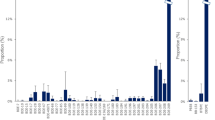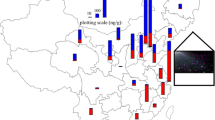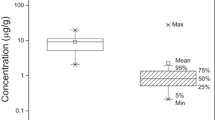Abstract
Flame retardants (FRs) are additives used in consumer products to reduce flammability, even though they can easily contaminate the indoor environment. Since it is common for people in modern cities to spend up to 85% of time indoors, the quality of the indoor environment is critical for human health. In this study, polybrominated diphenyl ethers (PBDEs), organophosphorus flame retardants (OPFRs), emerging brominated flame retardants (EBFRs), and dechlorane-related compounds (DRCs) were measured in household dust samples (n = 34) from Latvia, followed by human exposure assessment. Among all studied compounds, OPFRs showed the highest concentrations (1380–133,000 ng g−1). Despite the phase-out of PBDEs, they were the second most significant flame retardants in the studied dust samples (468–25,500 ng g−1) and the predominant compound was BDE-209. The concentrations of EBFRs were in the range of 120–7295 ng g−1, with the most abundant contaminant being DBDPE, which is widely used as a substitute for the deca-BDE formulation. DRCs were the least common flame retardants in the Latvian indoor environments, with concentrations ranging 22.4–192 ng g−1. Although the concentrations of specific FRs are known to vary between different countries, the levels and patterns observed in dust samples from Latvia were similar to those reported from Central Europe. Human exposure was evaluated as the estimated daily intake (EDI). The calculated exposure to most of the FRs was several orders of magnitude lower than the available reference dose (RfD) values.

Similar content being viewed by others
Data availability
The data that support the findings of this study are available from the corresponding author on request.
References
Abafe OA, Martincigh BS (2019) Concentrations, sources and human exposure implications of organophosphate esters in indoor dust from South Africa. Chemosphere 230:239–247
Ali N, Dirtu AC, Eede NV, Goosey E, Harrad S, Neels H, ’t Mannetje A, Coakley J, Douwes J, Covaci A (2012) Occurrence of alternative flame retardants in indoor dust from New Zealand: indoor sources and human exposure assessment. Chemosphere 88:1276–1282
Ali, N. et al., 2016. Brominated and organophosphate flame retardants in indoor dust of Jeddah, Kingdom of Saudi Arabia: implications for human exposure Sci Total Environ, Volume 569-570, pp. 269–277
Bearr JS, Stapleton HM, Mitchelmore CL (2010) Accumulation and DNA damage in fathead minnows (Pimephales promelas) exposed to 2 brominated flame-retardant mixtures, Firemaster® 550 and Firemaster® BZ-54. Environ Toxicol 29(3):722–729
Brandsma SH, de Boer J, Leonards PEG, Cofino WP, Covaci A, Leonards PEG (2013) Organophosphorus flame-retardant and plasticizer analysis, including recommendations from the first worldwide interlaboratory study. Trends Anal Chem 43:217–228
Brits M, Brandsma SH, Rohwer ER, De Vos J (2019) Brominated and organophosphorus flame retardants in South African indoor dust and cat hair. Environ Pollut 253:120–129
Brommer, S. & Harrad, S., 2015. Sources and human exposure implications of concentrations of organophosphate flame retardants in dust from UK cars, classrooms, living rooms, and offices Environ Int, Volume 83, pp. 202–207
Cequier E, Ionas AC, Covaci A, Marcé RM, Becher G, Thomsen C (2014) Occurrence of a broad range of legacy and emerging flame retardants in indoor environments in Norway. Environ Sci Technol 48:6827–6835
Coelho, S. D. et al., 2016. Brominated, chlorinated and phosphate organic contaminants in house dust from Portugal. Sci Total Environ, Volume 569-570, pp. 442–449
Cristale, J., Aragao Bele, T. G., Lacorte, S. & Rodrigues de Marchi, M. R., 2017. Occurrence and human exposure to brominated and organophosphorus flame retardants via indoor dust in a Brazilian city. Environmental Pollution, pp. 1–9
Cristale, J., Hurtado, A., Gómez-Canela, C. & Lacorte, S., 2016. Occurrence and sources of brominated and organophosphorus flame retardants in dust from different indoor environments in Barcelona, Spain. Environ Res, Volume 149, pp. 66–76
Cristale J, Lacorte S (2013) Development and validation of a multiresidue method for the analysis of polybrominated diphenyl ethers, new brominated and organophosphorus flame retardants in sediment, sludge and dust. J Chromatogr A 1305:267–275
Cristale, J. et al., 2012. Gas chromatography/mass spectrometry comprehensive analysis of organophosphorus, brominated flame retardants, by-products and formulation intermediates in water. Journal of Chromatography A, pp. 1-12
Crump D, Chiu S, Gauthier LT, Hickey NJ, Letcher RJ, Kennedy SW (2011) The effects of Dechlorane plus on toxicity and mRNA expression in chicken embryos: a comparison of in vitro and in ovo approaches. Comp Biochem Physiol C Toxicol Pharmacol 154:129–134
Dirtu AC, Ali N, van den Eede N, Neels H, Covaci A (2012) Country specific comparison for profile of chlorinated, brominated and phosphate organic contaminants in indoor dust. Case study for Eastern Romania, 2010. Environ Int 49:1–8
Dirtu AC, Covaci A (2010) Estimation of daily intake of organohalogenated contaminants from food consumption and indoor dust ingestion in Romania. Environl Sci Technol 44:6297–6304
Fan X, Kubwabo C, Rasmussen PE, Wu F (2014) Simultaneous determination of thirteen organophosphate esters in settled indoor house dust and a comparison between two sampling techniques. SciTotal Environ 491-492:80–86
He C, Wang X, Thai P, Mueller JF, Gallen C, Li Y, Baduel C (2017) Development and validation of a multi-residue method for the analysis of brominated and organophosphate flame retardants in indoor dust. Talanta 164:503–510
Hou R, Xu Y, Wang Z (2016) Review of OPFRs in animals and humans: absorption, bioaccumulation, metabolism, and internal exposure research. Chemosphere 153:78–90
Kademoglou K et al (2016) Legacy and alternative flame retardants in Norwegian and UK indoor environment: implications of human exposure via dust ingestion. Environ Int 102:48–56
Lee H-K et al (2020) Human exposure to legacy and emerging flame retardants in indoor dust: a multiple-exposure assessment of PBDEs. SciTotal Environ 719
Liagkouridis I, Cousins AP, Cousins IT (2015) Physical–chemical properties and evaluative fatemodelling of ‘emerging’ and ‘novel’ brominated and organophosphorus flame retardants in the indoor and outdoor environment. Sci Total Environ 524-525:415–426
Li W-L, Qi H, Ma WL, Liu LY, Zhang Z, Zhu NZ, Mohammed MO, Li YF (2015) Occurrence, behavior and human health risk assessment of dechlorane plus and related compounds in indoor dust of China. Chemosphere 134:166–171
Percy, Z. et al., 2020. Concentrations and loadings of organophosphate and replacement brominated flame retardants in house dust from the home study during the PBDE phase-out. Chemosphere, volume 239
Persson J, Wang T, Hagberg J (2018) Organophosphate flame retardants and plasticizers in indoor dust, air and window wipes in newly built low-energy preschools. SciTotal Environ 628-629:159–168
Rantakokko P, Kumar E, Braber J, Huang T, Kiviranta H, Cequier E, Thomsen C (2019) Concentrations of brominated and phosphorous flame retardants in Finnish house dust and insights into children’s exposure. Chemosphere 223:99–107
Saito I, Onuki A, H., S (2007) Indoor organophosphate and polybrominated flame retardants in Tokyo. Indoor Air 17:28–36
Shoeib T, Webster GM, Hassan Y, Tepe S, Yalcin M, Turgut C, Kurt-Karakuş PB, Jantunen L (2019) Organophosphate esters in house dust: a comparative study between Canada, Turkey and Egypt. Sci Total Environ 650:193–201
Sun, J. et al., 2018. Levels, occurrence and human exposure to novel brominated flame retardants (NBFRs) and Dechlorane Plus (DP) in dust from different indoor environments in Hangzhou, China. Sci Total Environ, Volume 631, pp. 1212–1220
Tao F, Sellström U, de Wit CA (2019) Organohalogenated flame retardants and organophosphate esters in office air and dust from Sweden. Environ Sci Technol 53:2124–2133
USEPA, 2017. Exposure factors handbook. S.l.:s.n
Van den Eede N et al (2012) Multi-residue method for the determination of brominated and organophosphate flame retardants in indoor dust. Talanta 89:292–300
Van den Eede N, Dirtu AC, Neels H, Covaci A (2011) Analytical developments and preliminary assessment of human exposure to organophosphate flame retardants from indoor dust. Environ Int 37:454–461
Vykoukalová M, Venier M, Vojta Š, Melymuk L, Bečanová J, Romanak K, Prokeš R, Okeme JO, Saini A, Diamond ML, Klánová J (2017) Organophosphate esters flame retardants in the indoor environment. Environ Int 106:97–104
Wang P, Zhang Q, Zhang H, Wang T, Sun H, Zheng S, Li Y, Liang Y, Jiang G (2016) Sources and environmental behaviors of Dechlorane plus and related compounds — a review. Environ Int 88:206–220
Wang Y, Sun H, Zhu H, Yao Y, Chen H, Ren C, Wu F, Kannan K (2018) Occurrence and distribution of organophosphate flame retardants (OPFRs) in soil and outdoor settled dust from a multi-waste recycling area in China. Sci Total Environ 625:1056–1064
Zacs D, Perkons I, Volkovs V, Bartkevics V (2019) Multi-analyte method for the analysis of legacy and alternative brominated and chlorinated flame retardants in food products of animal origin using gas chromatography - magnetic sector high resolution mass spectrometry. Chemosphere 230:396–405
Author information
Authors and Affiliations
Contributions
All authors contributed to the study conception and design. Material preparation, analysis, and data collection were performed by Elina Pasecnaja and Ingus Perkons. The study was supervised by Dzintars Zacs and Vadims Bartkevics. All authors contributed to the data analysis and writing the manuscript. All authors read and approved the final manuscript.
Corresponding author
Ethics declarations
Ethics approval
This is an observational study, no ethical approval is required.
Competing interests
The authors declare that they have no competing interests.
Consent to participate and publish
Not applicable.
Additional information
Responsible Editor: Constantini Samara
Publisher’s note
Springer Nature remains neutral with regard to jurisdictional claims in published maps and institutional affiliations.
Rights and permissions
About this article
Cite this article
Pasecnaja, E., Perkons, I., Bartkevics, V. et al. Legacy and alternative brominated, chlorinated, and organophosphorus flame retardants in indoor dust—levels, composition profiles, and human exposure in Latvia. Environ Sci Pollut Res 28, 25493–25502 (2021). https://doi.org/10.1007/s11356-021-12374-2
Received:
Accepted:
Published:
Issue Date:
DOI: https://doi.org/10.1007/s11356-021-12374-2




